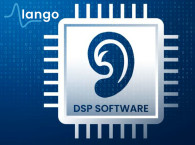The acoustic environment inside a car has unique challenges due to noise and reverberation. Engine, road, wind and rain noise can vary abruptly in amplitude and spectrum. Sound reflections from hard surfaces generate strong acoustic echoes with long echo tail. Alango’s automotive solutions have been custom developed to overcome these challenges and provide enjoyable voice and audio quality.
Now Alango has come up with a breakthrough technology for autonomous and assistive driving safety. It makes it possible to capture sounds from outside the vehicle without external microphones, while being insensitive to sounds inside the vehicle.
The importance of this technology for autonomous and assisted driving can hardly be overestimated. Detecting sirens and other external sounds is critical for these applications. Another application could be a type of “sound transparency” mode that allows people in the car to hear ambient sounds without opening a window, which can be important for safety in certain situations. Dash cams are another application where recording outside noise can help analyze the recorded video with sounds outside the camera field of view.
Recording external sound can be done by placing a microphone outside the vehicle cabin to be exposed to ambient sound only. However, placing microphones outside the cabin presents a significant challenge. Microphones are fragile and can be easily damaged while the body of a car is exposed to harsh environments: rain, wind, snow, hail, stones, oil, cleaning chemicals, high-pressure jet washers.
There is a simple solution that works. One can use a vibration sensor that attaches to the windshield or other window and record sound from the glass vibration. The same type of sensors as used for better voice acquisition in TWS earbuds (e.g., Airpods is an example) will work. There are several companies that have developed such MEMS sensors, e.g. Sonion, Infineon, Knowles, Merry Electronics, Goertek, Vesper, etc.

However, there is a major problem with any glass vibration signal. It is equally sensitive to sounds outside and inside a car. In many cases, when interior sounds are loud (e.g., music is playing), the corresponding vibration signal of interest (e.g., the siren) is contaminated by interior sounds. This prevents reliable detection of emergency sounds, prevents transparency mode, and affects the audio recorded by the dashcam.
That is where Alango's technology comes into play. Our DSP software technology enables cancellation of vibration signal components caused by internal noise, while preserving those caused by external sounds.
We call this technology SoundAround™.

Alango filed a patent application for this invention and is currently discussing cooperation with all the major MEMS voice sensor manufacturers.
For more information about SoundAround technology, visit the Alango website. There you can listen to audio samples of the vibration signal before and after SoundAround processing. There are also reference signals from outdoor and indoor microphones.
To perfect the technology and bring it to market, Alango has already begun a collaboration with a leading manufacturer of MEMS vibration voice sensors. More details will be available soon. SoundAround technology will be shown to customers and partners at the upcoming CES 2024 in January. Please contact Alango to schedule a demonstration.
www.alango.com

Headquartered in Israel, Alango Technologies is a leading provider of digital signal processing technologies for speech, hearing and audio applications. Companies use Alango's software in a wide range of devices, hands-free car kits, conference systems and speakerphones, Bluetooth headsets and TWS earbuds, hearing enhancement and assistive listening products, as well as smart speakers and other voice-controlled devices. Alango's innovative technology passes rigorous certification standards in even the most demanding and noisy environments. The company supports its customers at all stages, from a product concept discussion till the product tuning before the mass-production.
This article was originally published in The Audio Voice newsletter, (#435), August 31, 2023.










